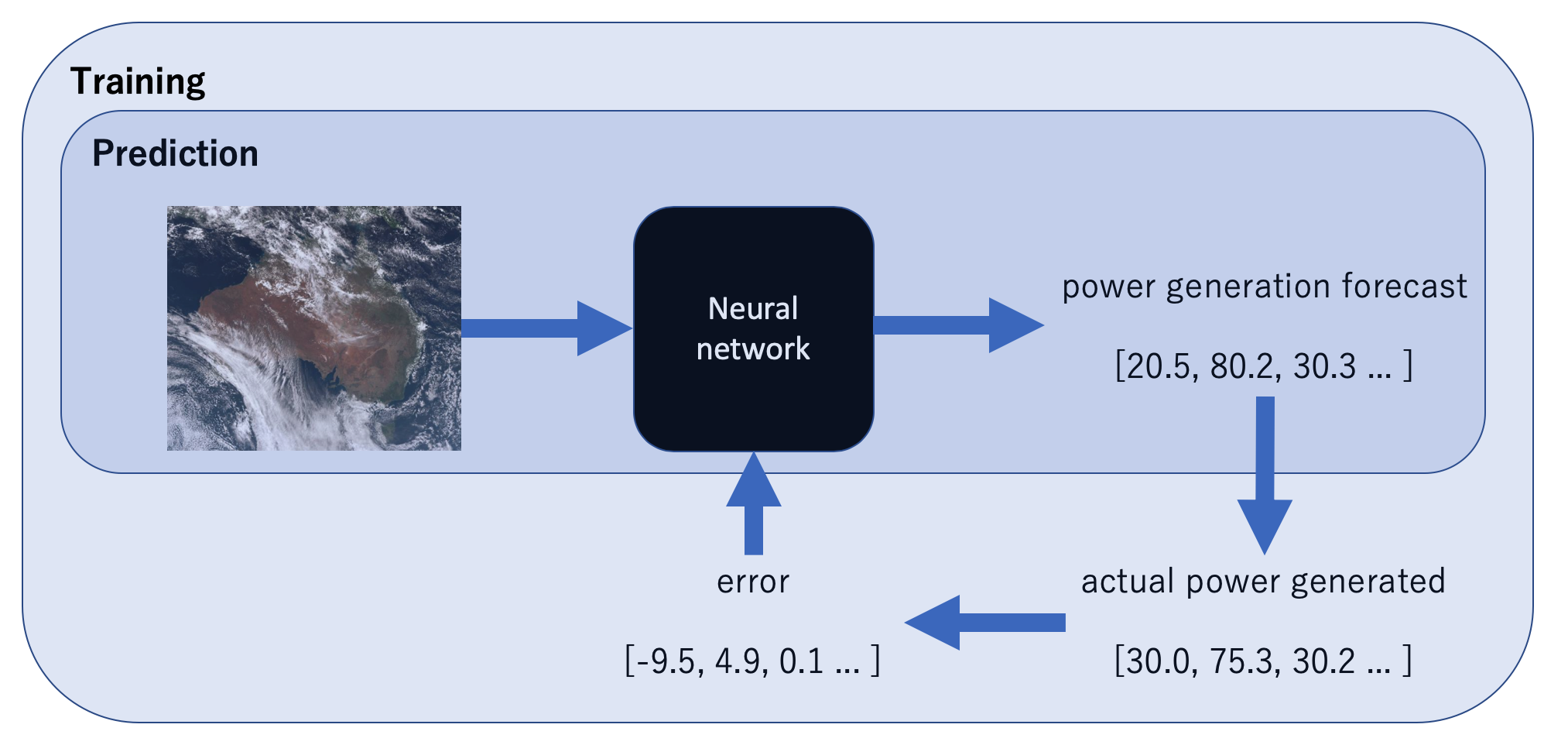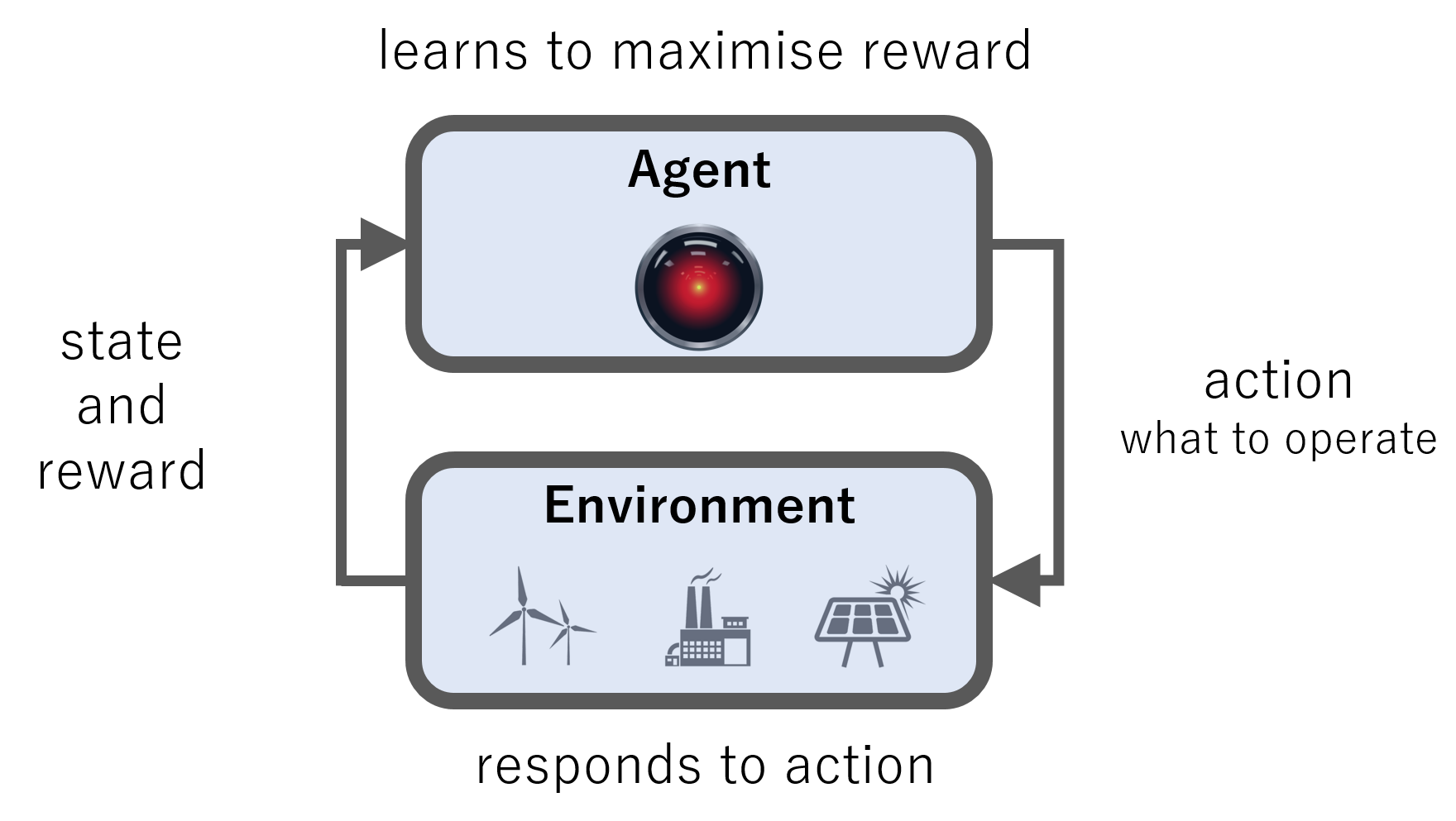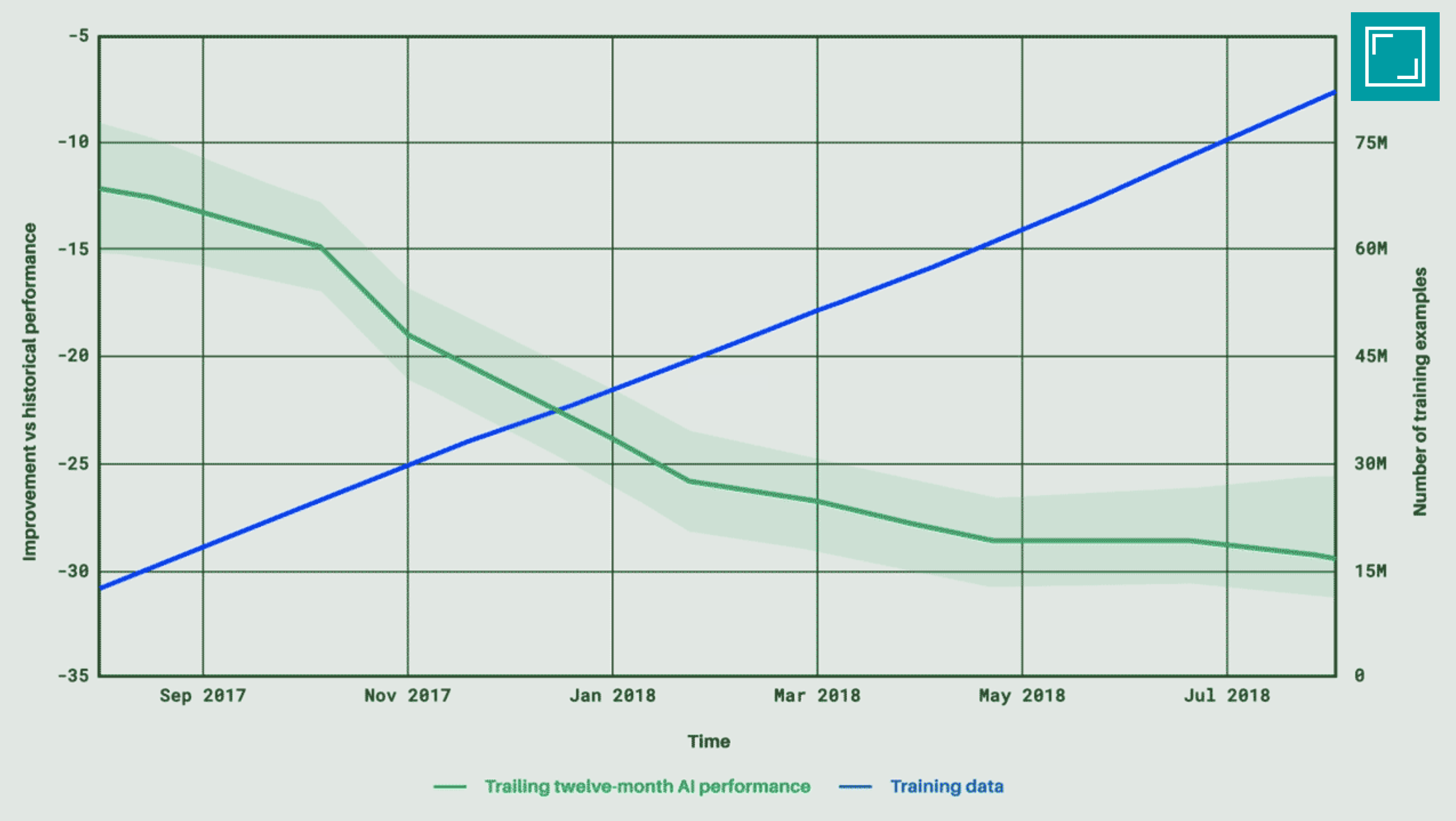Machine Learning in Energy
A guide for the energy professional.
This post is aimed at introducing energy industry professionals to machine learning - no prior knowledge is required.
By the end of the article you will be able to answer the following questions:
- what is machine learning?
- why is machine learning so hot right now?
- what is driving the performance of modern machine learning?
- what are the challenges?
This post finishes with a review of two of the most visible applications of machine learning in the energy industry - forecasting of wind and control of data centers.
Glossary
Artificial intelligence = machines that perceive the environment and take actions to achieve goals
Machine learning = a branch of AI, that gives computers the ability to learn high dimensional patterns from data
Deep learning = a family of machine learning models, that use multi-layered neural networks to approximate functions
What is Machine Learning?
Machine learning is the biggest advance in how we can do engineering since the scientific method - Steve Juvertson
The hype has officially peaked - as of 2018 deep learning is right at the top of the peak of inflated expectations.

Deep learning is foundation of the hype in modern machine learning. Deep learning uses complex, many layered neural networks to learn patterns from large datasets. This is the primary intelligence of machine learning - pattern recognition.
Machine learning has blown past the previous state of the art across a wide range of difficult problems. It is impacting every industry - this ability stems from the capability of neural networks to learn from the same raw high dimensional data that we use and learn from, such as images or text.
So where are we today? Currently, machine learning forms a core part of the breakthrough performance in computer vision and language processing. The state of the art on tasks object recognition, image classification, speech recognition and language translation are all powered by deep learning.
Google, Amazon and Facebook all have world class AI labs and much of their business has been transformed by machine learning. The potential of machine learning is more latent in industries that are less digitized (such as healthcare, energy or education).
Machine Learning versus Artificial Intelligence
So far machine learning has provided narrow artificial intelligence (AI). The power of these systems are often superhuman, and more than enough to justify the hype around machine learning. Typically the task involves perception, using high dimensional data (i.e. images). This is the main contribution of machine learning - being able to create business value from raw, high dimensional data.
This narrow intelligence stands in contrast to the goal of many AI researchers - general AI, where a machine can perform a single machine can variety of tasks. While it is almost certain that machine learning will form part of a general artificial intelligence, much more is needed to provide an intelligent machine that can perform a variety of tasks.
Machine learning and artificial intelligence shouldn’t be used interchangeably. Machine learning is only a subset of the broader field of AI. AI encompasses multiple distinct approaches that are beyond both the scope of this article.
One reason machine learning is often confused with AI is how well modern machine learning is performing - some researchers even think it’s all we will need to solve the general intelligence problem. What exactly is needed is unclear, but we are many breakthroughs away from providing general intelligence. Narrow superhuman machine intelligence is already here.
Three Branches of Machine Learning
To learn these patterns, machine learning makes use of three distinct learning signals, which separates machine learning into three branches.

The first is supervised learning, where the machine used labelled training data to learn how to predict the labels of unseen data. Examples include time series forecasting, computer vision and language translation. Supervised learning is the reason why Facebook can tell which of your friends is in your photo, or why Google can translate text from on a photo on your smart phone.

Recent progress in computer vision on the ImageNet benchmark - The Malicious Use of Artificial Intelligence: Forecasting, Prevention, and Mitigation
The second is unsupervised learning, where the machine is able to generate new data without the supervision of labels. Examples include artistic style transfer and generating realistic faces.
Generative Adversarial Networks (GANs) learn to generate realistic images using two competing neural networks. One network generates images (the generator) and a second network has to decide if the image is real or fake. This kind of adversarial learning is can be effective.

All the images to the right are machine generated - Karras et al. (2019) A Style-Based Generator Architecture for Generative Adversarial Networks (NVIDIA)
Adversarial learning can also be used in our final branch of machine learning - reinforcement learning. In reinforcement learning the machine learns to select actions with the supervision of a scalar reward signal. Reinforcement learning is applicable to a wide range of decision making problems with a reward signal, such as cost or carbon emissions.
The crown jewel of modern reinforcement learning is the 2016 AlphaGo victory over Lee Sedol. Go was the last great challenge for AI in board games - creating a superhuman Go computer was thought to be a decade away. AlphaGo used deep neural networks to map from the high dimensional board state to an optimal next move.

Lee Sedol in his eventual 4-1 loss to AlphaGo
AlphaGo stands in contrast to Deep Blue, the computer that solved chess with a 1996 victory over Garay Kasparov. All of Deep Blue’s intelligence originated from a team of programmers and chess Grandmasters, who handcrafted moves into the machine. Contrast this to the supervision that AlphaGo used - learning by playing itself at the game of Go.
DeepMind (the London lab behind AlphaGo) then introduced AlphaZero, which beat the previous version 100-0. This version never relied on a dataset of human expert moves, and learned entirely from adversarial self-play.
Why is Machine Learning So Hot Right Now?
Each of these three branches is undergoing a tremendous period of performance, research activity and hype. Fundamental to all of this improvement is deep learning - the use of multiple layer neural networks as complex function approximators.
These artificial neural networks are inspired by the biological neural networks in our own brains. The artificial neural networks used by machines are much simpler - yet they are powering the performance of modern machine learning.
A neural network is like any other function - it takes some input and produces an output. Reducing a high dimensional sample of data to a lower dimension is the fundamental process in machine learning. Examples include predicting solar power generation from satellite images, or dispatching a battery from grid data.

Neural networks are general purpose. If neural networks were only applicable in computer vision, this would still be a huge deal. Yet neural networks are pushing the boundaries in multiple directions. This generalizability of neural networks has allowed them to be state of the art across a wide range of problems, and also allows machine learning to be applied to a wide range of industries.
The atomic unit of a neural network is the perceptron - a simple model that combines input from other perceptrons, squeezes it through a non-linear function (such as a sigmoid or rectifier) and sends output to child perceptrons. The mathematics of this are beyond the scope of this article - the key takeaway is that stacking these perceptrons together into many layers allows neural networks to learn complex functions from large amounts of data.

There is more to machine learning than just deep neural networks - algorithms like logistic regression and random forests are suitable for many business problems. The problem with classical machine learning is that it doesn’t benefit from massive amounts of data. Because the capacity of a neural network can be increased by adding depth, neural networks are able to break through the limits of classical machine learning models.

Deep neural networks are able to learn from massive amounts of data - adapted from ‘AI is the New Electricity’ (Andrew Ng)
Layers are selected to take advantage of the structure in raw data. Three common layers are fully connected, convolution and recurrent.

Deep convolutional neural network used in the 2015 DeepMind Atari work
The convolutional layer is inspired by our own visual cortex, and is what powers modern computer vision. They allow machines to see. They can be used to classify the contents of the image, recognize faces and create captions for images.

An unrolled recurrent neural network - colah’s blog
A recurrent layer processes input and generates output as sequences, and powers modern natural language processing. Recurrent networks allow machines to understand the temporal structure in data, such as words in a sentence.
The ability to see and understand language not only drives performance, it also allows machine learning to generalize. Vision and language understanding are low level skills used in essentially every domain of human life. Mastering these low level skills means that machines can be useful in a range of industries. Energy is no different.
What’s Driving the Performance of Modern Machine Learning?
The performance of modern deep learning is driven by the interaction of two processes - the increased availability of data and the ability to train large models with lots of data.
The rise of the internet and devices that generate raw data (sensors, images and text) has lead to the curation of massive datasets. These massive datasets are the food of deep neural networks - without the data, the models can’t learn.
The ability to train large models rests upon the ability to access specialized hardware in the cloud. In the 2000s researchers repurposed hardware designed for video games (graphics processing units, or GPUs) to train neural networks. This led to dramatic speedup in training times, which is important - all our understanding of machine learning is empirical (learned through experiment).
The second hardware trend is cloud computing. The cloud gives access to computation on a fully variable cost basis. Platforms such as Amazon Web Services allow on-demand access to a large amount of GPU-enabled computing power with cheap data storage alongside it. This access to computing power works both vertically within large technology companies and for smaller companies. It enables the balance sheet benefit of shifting a capital expense (building data centres) into an operating expense.
A final trend driving modern machine learning is access to algorithms and tools. Almost all the relevant literature for machine learning is available without pay-wall on sites like arXiv. It’s also possible to access high quality implementations of machine learning tools on GitHub. This tendency for openness stands in stark contrast with the paywalls and licensed software of the energy industry.
Challenges
There are a wide range of challenges in machine learning. Examining them all is outside the scope of this article - issues such as interpretability, worker displacement and misuse of powerful narrow AI are significant issues and the focus of much research. There is also much work to be done extending the powerful, narrow machine intelligence we have today into a general artificial intelligence. Instead we will focus on challenges specific to using machine learning on energy problems.
The primary challenge is access to data. The energy industry is still in the process of digitization - all my work in the energy has involved setting up the basic data collection infrastructure. We’ve seen how important large amounts of data is to machine learning - a lack of historical data can be a show stopper for many energy and machine learning projects.
Forward thinking energy companies know that data can only be collected once. It’s more than just a local historian recording data from the site control system. The 21st century energy company has everything from sensor level data to accounting data available to the employees and machines that need it, worldwide and in near real time.
The curation of large and interesting datasets is one of the few defensible advantages an energy company can build (another is brand). These datasets are valuable not only because of how we can use them today, but because of the insights that can be generated tomorrow.
Applications
When thinking about applying machine learning to an energy problem, the first and most important consideration is the dataset. In fact, the first step in many machine learning projects is the same - start collecting data. A dataset for supervised machine learning has two parts - the features (such as images or raw text) and the target (what you want to predict). A dataset for reinforcement learning is a simulator - something that the learning algorithm can interact with.
Some potential applications of machine learning in energy include (but are not limited too):
- predictive maintenance,
- customer segmentation,
- churn prediction and minimization.
Now we will dive into the details of a few applications of machine learning in energy that are happening today.
Time Series Forecasting
The economics and environmental impact of energy depends on time of use. Forecasting has always been an important practice in energy - increased deployment of variable wind and solar makes forecasting more valuable. DeepMind have claimed a 20 % improvement in the value of energy using a 36 hour ahead forecast. Better forecasts can increase the value of renewables and reduce the requirement for backup fossil fuels.

Particularly exciting is the ability to forecast wind or solar using satellite images and deep convolutional neural nets - see the work of Jack Kelly and Dan Travers at Open Climate Fix.
Control
Optimal control of complex energy systems is hard. Reinforcement learning is a framework for decision making that can be applied to a number of energy control problems, availability of reward signals, simulators
Better control of our energy systems will allow us to reduce cost, reduce environmental impact and improve safety.

DeepMind’s data centre optimization is the most famous example of energy and machine learning. The algorithm makes decisions on a five minute basis using thousands of sensors. These sensors feed data into deep neural networks, which predict how different combinations of actions will affect the future efficiency of cooling generation.
This sounds like a form of DQN - a reinforcement learning algorithm that predicts future reward for each possible action.
The neural networks perform computations on the cloud, with the suggested action sent back to the data centre before safety verification by the local control system.

Performance of the data centre measured using energy input per ton of cooling (kW/tonC), and improves with more data, from an initial 12% to 30% over nine months.
Summary & Key Takeaways
We’ve had a whirlwind introduction to machine learning. Key takeaways are:
- machine learning is the subset of AI that is working,
- machine learning has three broad branches - supervised, unsupervised and reinforcement learning,
- deep learning is powering modern machine learning,
- convolution for vision, recurrent for sequences,
- performance is driven by the availability of data, cloud compute and algorithms.
Sources and Further Reading
For more technical and non-technical machine learning resources, check out ml-resources. For reinforcement learning resources, check out rl-resources.
Machine Learning
- Demis Hassabis (CEO DeepMind) – Artificial Intelligence and the Future
- Deep Blue – Wikipedia
- Alpha Go – Wikipedia
- Oh & Jung (2004) GPU implementation of neural networks
- The financial world wants to open AI’s boxes – MIT Technology Review
- Artificial Intelligence is the New Electricity - Andrew Ng
- Nuts and Bolts of Applying Deep Learning - Andrew Ng
- Paperclip maximizer
- What worries me about AI – François Chollet
- Software 2.0 - Andrej Karpathy (Tesla & OpenAI)
Machine Learning & Energy
- Machine Learning in Energy (Fayadhoi Ibrahima)
- 7 reasons why utilities should be using machine learning
- Germany enlists machine learning to boost renewables revolution
- Weron (2014) Electricity price forecasting: A review of the state-of-the-art with a look into the future
- Re-dispatch costs in the German power grid
- This “duck curve” is solar energy’s greatest challenge
- 7 reasons why utilities should be using machine learning
Time Series Forecasting
- Machine Learning in Energy (Fayadhoi Ibrahima)
- 7 reasons why utilities should be using machine learning
- Germany enlists machine learning to boost renewables revolution
- Weron (2014) Electricity price forecasting: A review of the state-of-the-art with a look into the future
- Re-dispatch costs in the German power grid
- This “duck curve” is solar energy’s greatest challenge
Energy Disaggregation
- Neural NILM: Deep Neural Networks Applied to Energy Disaggregation
- Energy Disaggregation: The Holy Grail (Carrie Armel)
- Putting Energy Disaggregation Tech to the Test
Control
- Minh et al. (2016) Human-level control through deep reinforcement learning
- Reinforcement learning course by David Silver (Google DeepMind)
- Deep reinforcement learning doesn’t work yet
Thanks for reading!